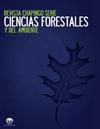麻疯树(Jatropha curcas L.)根际分离菌:植物病原菌和植物生长促进剂的拮抗活性
IF 0.5
4区 农林科学
Q3 Agricultural and Biological Sciences
Revista Chapingo Serie Ciencias Forestales Y Del Ambiente
Pub Date : 2020-04-30
DOI:10.5154/R.RCHSCFA.2020.04.029
引用次数: 0
摘要
简介:麻疯树是一种原产于墨西哥的物种,最近被认为是生产生物燃料的重要作物。目的:分离鉴定对该作物植物病原真菌新月弯孢(Curvularia lunata)和马齿镰刀菌(Fusarium equiseti)具有拮抗活性的根瘤菌,并评价其促进番茄生长的能力。材料和方法:通过连续稀释获得分离物,并用挥发性和扩散性化合物在PDA培养基上评估其拮抗活性。此外,还测定了促进植物生长的抗真菌化合物和代谢产物的产生。通过扩增16S RNA和sodA基因对分离株进行鉴定。最后,将分离株接种在番茄种子上,评价其对番茄生长的促进作用和发芽率。结果与讨论:经鉴定,拮抗菌为莫哈韦芽孢杆菌、枯草芽孢杆菌、苏云金芽孢杆菌和铜绿假单胞菌。由于存在抑制率在30%至79%之间的挥发性和可扩散化合物,因此对轮状弯孢菌和马齿苋菌丝生长的抗真菌作用。铜绿假单胞菌的抑制作用最强(48.7%~79.8%)。枯草芽孢杆菌(A1)、莫哈韦芽孢杆菌(A4)和苏云金芽孢杆菌(A6,A8)的发芽率最高(70%-88%)。结论:从油麻中分离得到的8株根际细菌对月桂树和木贼具有拮抗活性,并具有促进番茄发芽和生长的作用本文章由计算机程序翻译,如有差异,请以英文原文为准。
Isolated rhizobacteria of Jatropha curcas L.: antagonistic activity of phytopathogens and plant growth promoter
Introduction:Jatropha curcas L. is a species native to Mexico that has recently been considered an important crop to produce biofuel. Objective: To isolate and identify rhizobacteria from J. curcas with antagonistic activity against phytopathogenic fungi (Curvularia lunata and Fusarium equiseti) of this crop and evaluate their capacity to promote tomato plant growth. Materials and methods: The isolates were obtained by serial dilution and antagonistic activity was assessed by volatile and diffusible compounds on PDA medium. In addition, the production of antifungal compounds and metabolites that promote the plant growth were determined. The isolates were identified by amplifying the 16S RNA and sodA genes. Finally, the isolates were inoculated on tomato seeds to evaluated plant growth promotion and germination. Results and discussion: The antagonistic bacteria were identified as Bacillus mojavensis, Bacillus subtilis, Bacillusthuringiensis, and Pseudomonas aeruginosa. The antifungal effect on the mycelial growth of C. lunata and F. equisetiwas due to the presence of volatile and diffusible compounds with between 30 % and 79 % inhibition. Pseudomonas aeruginosa showed the strongest inhibitory effect (48.7 to 79.8 %). Bacillus subtilis (A1), B. mojavensis (A4) and B. thuringiensis (A6, A8) showed the highest germination (70 % to 88 %). The vegetative growth of tomato plants treated with the isolates was significantly higher than the controls(P < 0.05). Conclusion: Eight rhizobacteria isolated from J. curcas showed antagonistic activity against C. lunata and F. equiseti and demonstrated their capacity to improve the germination and promote growth in tomato plants
求助全文
通过发布文献求助,成功后即可免费获取论文全文。
去求助
来源期刊
CiteScore
1.20
自引率
16.70%
发文量
0
审稿时长
>12 weeks
期刊介绍:
The Revista Chapingo Serie Ciencias Forestales y del Ambiente (RCHSCFA) is a scientific journal that aims to raise awareness of high-quality research products related to forest, arid, temperate and tropical environments in the world. Since its foundation in 1994, the RCHSCFA has served as a space for scientific dissemination and discussion at a national and international level among academics, researchers, undergraduate and graduate students, forest managers and public/private entities that are interested in the forest environment.
All content published in the journal first goes through a strict triple-blind review process and is published in the following formats: Scientific Articles, Review Articles, Methodologies, Technical or Technological Notes.

 求助内容:
求助内容: 应助结果提醒方式:
应助结果提醒方式:


